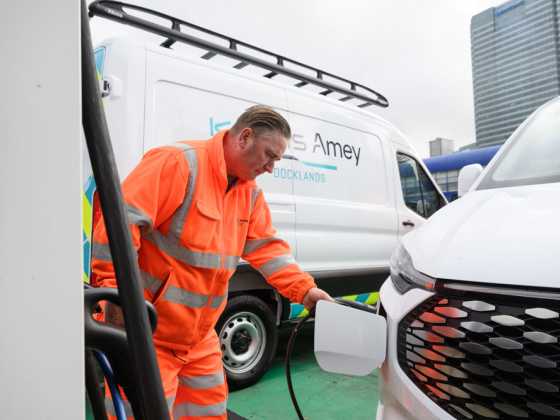Driving towards a zero-emission truck sector

With bold phase-out dates for diesel and petrol trucks in place, and a raft of meaures announced to ease the transition to zero-emission trucks, Andy Eastlake from the Zemo Partnership runs through the latest developments in HGV decarbonisation, including progress of the Zero Emission Road Freight demonstration programme
The focus of road transport decarbonisation policy has been moving beyond cars and vans and, increasingly, to the freight sector which now finds itself close to the centre of the spotlight.
Road freight contributed nearly a fifth of UK transport’s annual greenhouse gas emissions (GHG) in 2020, and HGVs are also a main source of roadside nitrogen oxides and particulates that are damaging to human health.
At last year’s climate conference (COP26) in Glasgow, the government announced bold phase-out dates to ensure that all new HGVs sold in the UK are zero emissions at the tailpipe by 2040 at the latest, with sales of non-zero emission vehicles under 26 tonnes to be phased out by 2035. This ambition puts the UK in the vanguard of international efforts to decarbonise road freight. Reflecting the challenges that some have raised, the government has recently closed a call for evidence on potential exemptions to the 2035 deadline and a response is expected soon, though the 2040 date for all HGVs is currently seen as a ‘hard back-stop’.
Industry progress
Manufacturers have already seen the writing on the wall and zero emission HGVs are now appearing in increasing numbers, with encouraging indications they may be built in the UK.
To support their uptake, the government recently announced an extension to the plug-in truck grants (PITrG) until 2024/25. This reduces the purchase price of zero emission commercial vehicles with grant rates for eligible trucks set at 20 per cent of the purchase price (up to £25,000 of funding available for the largest HGVs). The number of vehicles eligible for the grant (introduced in 2017) is expanding and Zemo is supporting OEMs directly with applications and in getting the information on ZE truck performance into the public domain. The purchases of over 100 zero emission HGVs have been supported to date and total plug-in truck grant orders rose eight-fold between 2020 and 2021, though from a very modest base. It’s still the case, however, that the current level of grant compared with the increased capital cost can, today, still leave a gap in the financial case for changing to a ZE truck, particularly in the heavier, larger and longer distance applications where charging or fuelling infrastructure becomes a critical challenge.
Zemo Partnership was particularly encouraged, therefore, by the recent announcement that over £200m funding is to be made available for an extensive zero emission road freight (ZERF) demonstration programme, aiming to bring the “world’s largest (in both senses) fleet of zero emission HGVs” to UK roads. Zemo and our members have been working closely with government officials to develop the programme which will build on the £20m ZERF trials and feasibility studies, announced in July 2021.
The new three-year programme will begin later this year with details of the initial competitions expected imminently (at the time of writing!). These will invite manufacturers, energy providers and fleet and infrastructure operators to showcase their ‘green’ technologies together on UK roads, beginning with demonstrations of battery electric and hydrogen fuel cell HGV operations.
ZERF progress
ZERF completed Phase One feasibility and supply chain work at the end of March. The upcoming demonstrations (our working title ZERFD?) will shape the long-term decisions about what technology and energy will power our HGVs after 2030. Critically important is the collaborative ‘system’ approach needed for this programme to demonstrate how the UK’s future charging and energy structures will need to look if they are to effectively support the operational and commercial implications arising from the adoption of zero emission truck technology. To help government with this challenge, Zemo was very pleased to be working alongside both National Highways and National Grid in an advisory and supporting capacity.
As part of the ZERF trials introduced last year, Leyland Trucks provided 20 DAF battery electric HGVs for use by public sector organisations, including the NHS and local authorities (Bett.cenex.co.uk). This and other initiatives enabled evidence and experience to be gathered from field testing vehicles in a real-world, real-time logistics environment. Along with six other successful feasibility studies, this project helped prepare for larger demonstrations, which will take place over the coming years.
Zemo will continue to play a major role in supporting the demonstration programme as well as helping to disseminate the learnings as they emerge.
Partnership working
In June this year, the government published what it describes as the first-ever cross-modal and cross-government plan for the UK freight sector. Developed in partnership with industry, the plan identifies the main challenges, objectives and actions that need to be taken in five priority areas, one of which is to enable the transition to net zero. Government says it intends to forge a new open and honest relationship with stakeholders in the sector to collectively assess its future energy and fuel needs through a Freight Energy Forum.
The plan represents a starting point for government-industry collaboration, of which Zemo Partnership will be a leading enabler. Its shared aim is the achievement of a net zero wholes freight and logistics sector by 2050, while supporting the broader environmental objectives of air quality and noise reduction. It focuses not just on the adoption of zero emission vehicle technologies and associated infrastructure but on modal shift, cross-modal freight journeys as well as advances and innovations in logistical solutions.
What can be done now?
Though the transition to zero emission freight is happening fast, zero emission vehicle options will not be available in many categories for some years to come. So what should operators do in the near and medium-term?
Zemo has long been an advocate of the use of high blend renewable fuels in the HGV sector to make an immediate and significant carbon reduction in the near and medium-term. For operators considering buying a truck today, a gas-powered option (running on biomethane of course) could well be a compelling proposition. With the fuel duty differential between gas and diesel in place until 2032 at least, there’s a strong financial case for investing in a long-haul truck powered by biomethane. Several OEMs have product available today and the gas suppliers are ramping up the already pretty extensive refueling network to make this one of the best propositions for decarbonising heavy trucks for the next few years at least.
Renewable diesel may also be an option today, and B100 is a near-term possibility after some small modifications to trucks and depot storage. Hydrotreated vegetable oil (HVO) is gaining adherents quite fast and high FAME blends, if fully assured in terms of their sustainability, can deliver the same 80-90 per cent greenhouse gas emissions reductions on a well-to-wheel basis as we see from biomethane. Current work by Zemo (supported by both UKPIA and RTFA) is looking to further incentivise the use of high blend renewable fuels to rapidly decarbonize the current HGV fleet (and non-road mobile machinery) while zero emission solution are developed.
Current market support initiatives include Zemo’s Renewable Fuels Assurance Scheme which now covers over 85 per cent of the renewable fuels sold in the UK and provides operators with the evidence that the fuels supplied to them realise the benefits that their suppliers claim.
The Freight Portal
The Freight Portal, developed in a collaboration between Zemo, Energy Saving Trust and the Department for Transport aims to provide core advice and case studies to freight operators on the options for decarbonising their fleets, directing them towards a range of schemes providing lower costs and emissions.
A focus of the Freight Portal is to measure and reduce the fuel used in today’s fleets. The Portal aims to be a ‘one stop shop’, consolidating advice on technology accreditation, operational optimisation, clean air zone compliance, telematics use, driver behavior and other key considerations for operators seeking to make the transition. It helps identify through clear case studies, how fleets can start and accelerate their journeys to net zero at the highest pace and lowest cost possible.
Zemo Partnership runs an active Commercial Vehicle Working Group through which members can keep up to date on policy developments and also influence their direction.
Amongst other projects, Zemo provides technical and promotional support to the ZERF programme, is investigating the development of zero emission ancillary systems (such as thermal refrigeration units – TRUs) and has also been developing an emissions test cycle for vans. The group also provides general policy advice and support to Government on the decarbonisation of UK freight.
There is a long road ahead to fully decarbonise freight and, I’m sure, there will be bumps along the way, but Zemo and our community of stakeholders can help to signpost a complete portfolio of information advice and support. So whether you’re just starting out and considering fuel monitoring and driver training and a lower carbon fuel in your existing trucks, or if you are ready to invest in a demonstration fleet of the latest hydrogen fuel cell pilot vehicles and infrastructure, there’s something for everyone and steps we can all take, together.
Significant progress is beginning to be seen in the UK’s transition to a zero emission freight sector and it’s an exciting time to be involved.
Useful links:
www.thefreightportal.org/
www.zemo.org.uk/work-with-us/commercial-vehicles
www.gov.uk/plug-in-vehicle-grants






